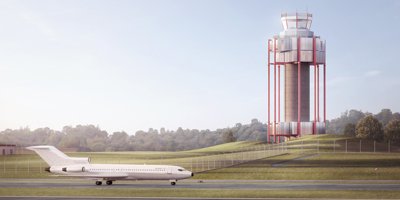The Federal Aviation Administration (FAA) has selected a visually striking and sustainable design for new air traffic control towers, to replace the current outdated towers at more than 100 municipal and regional airports in the US.
The design by New York’s Practice for Architecture and Urbanism (PAU) meets key sustainability requirements and can adjust the height of the tower to meet the traffic and vision requirements of each airport, while reducing construction costs and operational
According to the firm, it has developed a new generation of air traffic control towers with an adaptable and sustainable design. Inspired by the Chinese American architect IM Pei’s iconic mid-century towers, the design combines aesthetics and functionality for the modern era. PAU’s simplified model showcases its structural, mechanical and operational building systems, with visually captivating geometries and exposed beams and columns.
The new air traffic control towers are standardized but very flexible, allowing for custom colors and materials to suit the unique characteristics of each location. They are designed to accommodate different structural systems, ranging from 19.2 to 36.3 m (63 to 119 ft) and use a combination of precast concrete and sustainable cross-laminated timber (CLT) for floors and walls. This ensures compliance with seismic and climate requirements for various regions.
The interior spaces prioritize the well-being of air traffic controllers, with integrated daylighting, comfort systems and fresh air ventilation to create a hygienic environment. Materials and finishes are chosen to facilitate maintenance over long periods of time.
To promote sustainability, PAU’s design incorporates geothermal heating and cooling for clean, renewable energy generation. Other green features include steel and metal products with a high recycled content, low-carbon building materials, ultra-efficient water equipment and fixtures, advanced energy monitoring systems, high-performance facades with thermal bridges minimums and all-electric building systems.
The modular design of the PAU prototype allows for efficient construction, focusing on shop fabrication over on-site work. This approach reduces the carbon footprint associated with each tower.
“We are grateful and honored to have the opportunity to design the nation’s next generation of air traffic control towers, an important component of US Transportation Secretary Pete Buttigieg’s plan to achieve net zero greenhouse gas emissions greenhouse effect (GHG) of the US aviation sector by 2050,” says PAU Principal Founder and Chief Creative Officer Vishaan Chakrabarti. “As a practice that finds great creative possibility within tight constraints, we are thrilled to ‘accept this challenge to create a beautiful and functional architecture that meets the needs of air traffic controllers across the country while improving safety and reliability for the traveling public.’
FAA preferences include designing with standardized elements to reduce construction and operating costs while allowing the building to adapt to local climate and location issues, such as very high and very low temperatures, environments wet and dry and strong winds.
The initial set of 31 control towers at the candidate airports would replace towers that are operating beyond their intended useful life. The FAA has set aside more than $500 million from the bipartisan Infrastructure Act to support site assessment, preparation, and early construction activities.
The first break could start in 2024.

